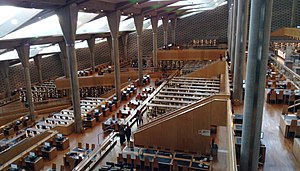The Bibliotheca Alexandrina (Latin for “Library of Alexandria”; Egyptian Arabic: مكتبة الإسكندرية Maktabet al-Eskendereyya). It is a major library and cultural center on the shore of the Mediterranean Sea in Alexandria, Egypt. It is a commemoration of the Library of Alexandria, once one of the largest libraries worldwide, which was lost in antiquity. The idea of reviving the old library dates back to 1974 when a committee set up by Alexandria University selected a plot of land for its new library. Construction work began in 1995, and after some US$220 millions had been spent, the complex was officially inaugurated on 16 October 2002. In 2010, the library received a donation of 500,000 books from the Bibliothèque nationale de France (BnF). The gift makes the Bibliotheca Alexandrina the sixth-largest Francophone library in the world.

History
The idea of reviving the old library dates back to 1974 when a committee set up by Alexandria Universty selected a plot of land for its new library between the campus and the seafront, close to where the ancient library once stood. The recreation of the ancient library was not only adopted by other individuals and agencies. It garnered support from Egyptian politicians. One leading supporter of the project was former Egyptian President Hosni Mubark . UNESCO was also quick to embrace the concept of endowing the Mediterranean region with a center of cultural and scientific excellence. This initiative by the Egyptian government, UNESCO, and Alexandria University was with the aim of re-establishing Alexandria as one of the great intellectual and cultural centres of the twenty-first century”. UNESCO’s involvement beginning in 1986 created a great opportunity for the project to truly be international in focus.
Building and library features
The library has shelf space for eight million books, with the main reading room covering 20,000 square metres (220,000 sq ft) on eleven cascading levels. The complex also houses a conference center; specialized libraries for maps, multimedia, the blind and visually impaired, young people, and for children; four museums; four art gallaries for temporary exhibitions; 15 permanent exhibitions; a planetarium; and a manuscript restoration labratory. The library’s architecture is equally striking. The main reading room stands beneath a 32-meter-high glass-panelled roof, tilted out toward the sea like a sundial. It measures some 160 m in diameter. The walls are of gray Aswan granite, carved with characters from 120 scripts.
People all over the world donated the collections at the Bibliotheca Alexandrina . The Spanish donated documents that detailed their period of Moorish rule. The French also donated, giving the library documents dealing with the building of the Suez Canal .
Here are some of the areas and exhibits that it comprises:
The main library
Can hold up to 8 million books.
Six specialized libraries
- The Arts and Multimedia Library
- The Taha Hussein Library for the visually impaired
- The Children’s Library
- The Young People’s Library
- The Microforms Library
- The Rare Books and Special Collections Library
A copy of the Internet Archive
The library provides access to print on demand books via the Espresso Book Machine.




Comment (0)